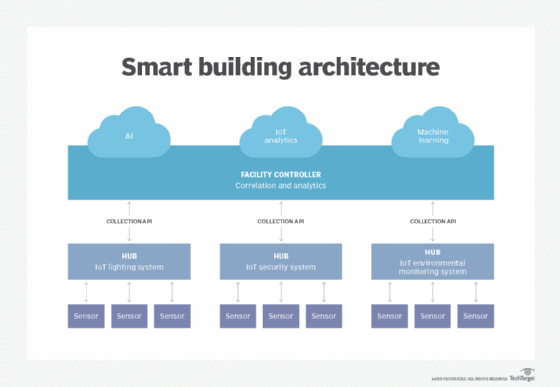
TTstudio - Fotolia
How to construct an effective smart building architecture
While buildings are physically erected from the ground up, an IoT smart building is most effective when constructed from the top-down.
The internet of things is an incredibly hot topic, and interest is so great it may have obscured the central truth about IoT: It isn't about the things themselves; it's about being smart. It's the application of intelligence to sensor data that makes IoT useful and real -- especially in the context of a building. As such, the architecture of a smart building is a great place to start. All of our IoT applications can build up from smart building principles, and all IoT business cases can be rooted there.
The most important truth about today's smart buildings is that they aren't designed from the top-down but assembled from the bottom-up. That's because security, facility controls and other IoT systems found in smart buildings are generally independently designed and deployed separately.
To truly garner the benefits an IoT smart building has to offer, it's critical to take a top-down approach and have all IoT systems working together. Here's how it's done.
Understanding the layers of smart building
First, it's important to understand the layers of a smart building architecture and its components. Each system -- be it security, facility control or any other number of IoT applications -- consists of two logical layers:
- a sensor and controller layer that provides direct connection to the environment, and
- a system hub that connects the sensor and controller layer to its primary source of intelligence and connectivity -- and to the facility controller (more on that below).
The system hub is a critical element in any smart building because it's the point where APIs are exposed to enable an information exchange with other smart building elements.
A system hub is usually a specialized device that includes software and features that relate to the specific mission of the system -- security, environmental monitoring and control, lighting, elevators and escalators, and others. The basic behavior of each system is under the control of the hub. Sensor data is also handled in the system hub and fed back in a control loop to change what's happening at the device level. This approach ensures a short control loop, meaning a minimal delay between when something is sensed and when an action is triggered.

Where the smarts of an IoT smart building live
The real smarts in a smart building are created by the element at the top: a device that manages the flow of data, which I'll refer to as the facility controller. This is likely a collection of applications running on traditional servers or in the cloud, and it connects at the bottom to the APIs exposed by the IoT system hubs of the building's IoT deployments. In most IoT applications, the facility controller doesn't provide system-specific details but rather integrates across systems to build a higher level of control intelligence. It's this facility controller that creates smart buildings, and a hierarchy of these facility controllers turns smart buildings into smart complexes -- and eventually into smart cities.
Facility controllers are made up of three conceptual pieces in a smart building architecture: the collection APIs, correlation and analytics, and rules and policies. Everything in smart building IoT is created by the cooperative action of these three elements.
Collection APIs create the links with system hubs, and these enable the facility controller to see specific events and generate control responses. In most cases, collection APIs won't capture everything the system hub does or direct every response but instead will extract signals representing special conditions. In some cases, these APIs will also be used to push policies to the system hubs, such as those that control how the hubs themselves will respond to their own events.
Correlation and analytics are the heart of the facility controller. They represent the place where the largest number of technology options can be identified, as well as where the greatest potential of new technologies, such as AI and machine learning, can be introduced. Broadly, the correlation of conditions across system hubs is the basis for building smarts because it collects a systemic vision of conditions. Complex event processing can be an element of this, but the current focus is on the application of AI techniques -- more specifically, machine learning -- to distinguish between a simple report of a condition and an alert that something abnormal is happening.
A systemic view of conditions is a critical piece of the smart building IoT puzzle. The conditions include basic things like time of day, day of the week, holiday schedules and even the weather, all of which can often be obtained from system hubs. Some of these will require policies. System-specific conditions, such as whether the heating system is operating correctly, city power is available, network connectivity is normal and any systems in the building are in alert status, must also be gathered, put into a timeline and then correlated for handling. A facility controller has to normalize the events reported via the collection APIs to a single set of events to facilitate cross-correlation and the application of rules.
Rules and policies can be either directly input by specialists who control the building systems, developed through AI processes or both. Generally, policies are constraints placed on the actions triggered by rules that a facility controller can take. Rules are tests of system-wide conditions that can then cause the facility controller to send commands to system hubs and, through the hubs, to the various devices in the IoT network.
An example of an application of the elements of facility control is easily found in security. A power failure is a condition that generally isn't a security alert, but if a power failure is followed shortly by a loss of communications and if a perimeter alarm is then generated, the combination may be a signal to enter a high-alert state and notify security or the police.
Extending the smart building architecture to smart cities
The goal of the industry's work on smart buildings, plants and cities is not to force an identical implementation on all these things, but to define a common architecture that will permit the use of common software components for as many of the functional layers we've discussed as possible.
Smart facilities have to accommodate the widest possible range of sensors and control devices and the greatest number of system hubs currently in use. If not, they force expensive upgrades to sensor and control technology. Too many variations in the software elements of facility controllers mean a high risk of silos of technology that limit users' ability to adopt new technologies as they become available.
If IoT is new and exciting, it's because it's stepping beyond the sensors and hubs that define it today. Especially in the smart building market, which is expected to reach global spending of $61.9 billion by 2024 at a compound annual growth rate of 34% between 2017 and 2024.
Facility-wide correlation of events and the coordinated control of multiple systems are the leading edge of IoT. That correlation starts with the smart building and so should IoT planning.







